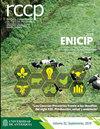Use of oral fluids for efficient monitoring of influenza viruses in swine herds in Colombia
IF 0.5
4区 农林科学
Q4 AGRICULTURE, DAIRY & ANIMAL SCIENCE
引用次数: 2
Abstract
34 Background: Influenza A virus (IAV) surveillance in swine is critical due to the direct impact of 35 the disease in pork industry but also because IAV are prone to interspecies transmission (from 36 human to pigs and vice versa), and therefore its monitoring is critical from public and animal health 37 perspectives. Currently there are several diagnostic techniques available to detect IAV infection 38 Received: May 17, 2021; Accepted: October 5, 2021 Corresponding author: Karl Ciuoderis. Laboratorio Genómico One Health, Universidad Nacional de Colombia, bloque M15, Medellín, Colombia. E-mail: coord_cwohc@unal.edu.co This work is licensed under a Creative Commons Attribution-NonCommercial-ShareAlike 4.0 International License. eISSN: 2256-2958 Rev Colomb Cienc Pecu from nasal samples in swine, however, other samples such as oral fluids (OF) have been 39 implemented as novel alternatives for pathogen detection. The OF allow an efficient and feasible 40 detection of diseases at lower cost at a herd level, with lower risk of stress for animals. Objective: 41 Describe a surveillance strategy of IAV at herd level during respiratory disease outbreaks in swine 42 farms in tropical settings using porcine oral fluids. Methods: Active surveillance strategy was 43 conducted in five selected swine farms with past records of respiratory disease. Swine OF were 44 collected for IAV testing. An OF sample was described as a pen-based specimen collected from a 45 group of >20 pigs per pen and/or per barn (if they were stall-housed individually but having close 46 contact between them). IAV infection was investigated in OF by rRT-PCR testing, and confirmed 47 by viral isolation in cell culture. Results: IAV detection was conducted in five purposively selected 48 farms between 2014-2017. We investigated a total of 18 respiratory disease outbreak events. From 49 the total 1444 OF samples tested, we found 107 (7.4%) positives to IAV by rRT-PCR. 50 Additionally, 9 IAV isolates were obtained, and all were further identified as H1 subtype. 51 Conclusions: Results of our study demonstrated how OF can be easily implemented as a novel, 52 user-friendly, welfare-friendly, accurate and cost-effective sampling method for active 53 surveillance and monitoring of IAV infections in swine farms in tropical settings. 54使用口服液对哥伦比亚猪群流感病毒进行有效监测
34背景:由于甲型流感病毒(IAV)在猪肉行业的直接影响,对猪的监测至关重要,但也因为IAV容易在种间传播(从36人传播到猪,反之亦然),因此从公共和动物健康的角度来看,对其监测至关重要。目前有几种诊断技术可用于检测IAV感染38收到日期:2021年5月17日;接受时间:2021年10月5日通讯作者:Karl Ciuoderis。哥伦比亚国立大学Genómico One Health实验室,M15,哥伦比亚麦德林。电子邮件:coord_cwohc@unal.edu.co这部作品是根据知识共享署名非商业共享4.0国际许可证授权的。eISSN:2256-2958 Rev Colomb Cienc Pecu来自猪的鼻腔样本,然而,其他样本如口服液(OF)已被39用作病原体检测的新替代品。OF允许在群体水平上以较低的成本高效可行地检测疾病,降低动物的压力风险。目的:41描述在热带地区42个养猪场使用猪口服液爆发呼吸道疾病期间,在牛群水平上监测IAV的策略。方法:对5个有呼吸道疾病史的养猪场进行43次主动监测。采集44头OF猪进行IAV检测。OF样本被描述为从每个围栏和/或每个畜棚的45组>20头猪中采集的围栏样本(如果它们被单独安置,但它们之间有密切的46次接触)。通过rRT PCR检测在OF中调查IAV感染,并通过细胞培养中的病毒分离确认47。结果:2014-2017年间,在5个有针对性地选择的48个农场中进行了IAV检测。我们总共调查了18起呼吸道疾病爆发事件。在总共检测的1444个OF样本中的49个样本中,我们通过rRT PCR发现107个(7.4%)IAV阳性。50此外,获得了9个IAV分离株,并进一步鉴定为H1亚型。51结论:我们的研究结果表明,of是一种新的、52用户友好、福利友好、准确且具有成本效益的采样方法,可以很容易地用于热带地区养猪场的IAV感染的主动监测和监测。54
本文章由计算机程序翻译,如有差异,请以英文原文为准。
求助全文
约1分钟内获得全文
求助全文
来源期刊

Revista Colombiana De Ciencias Pecuarias
AGRICULTURE, DAIRY & ANIMAL SCIENCE-
CiteScore
0.80
自引率
0.00%
发文量
18
审稿时长
6-12 weeks
期刊介绍:
The editors of Revista Colombiana de Ciencias Pecuarias (RCCP) welcome the submission of original manuscripts on experimental and clinical studies associated with the broad areas of animal sciences and veterinary medicine as they interface with biochemistry, molecular biology, physiology, pharmacology, toxicology, pathology, microbiology, parasitology, immunology and epidemiology. The scope of the journal includes studies of basic and applied research in animal management and production, feeding and nutrition, reproduction, breeding, genetics, animal welfare and behavior; as well as animal production focussed from biotechnology, soil science, agrostology, silvopastoral systems, livestock economics and the environment.
The criteria for acceptance of papers submitted for publication are originality, quality and clarity of the content. Each contribution must be based on original, unpublished research that has not been simultaneously submitted to other journals. All papers will be peer reviewed. All authors bear responsibility for ensuring the integrity and quality of their reported research. It is the author''s responsibility to secure permission to use figures or tables that have been published elsewhere.
Contributions may be classified as original research, review, rapid communication, clinical case studies or methodological articles, as well as news/commentaries or letters to the editor. Most review articles are invited by the editor. Authors interested in submitting a review article should contact the corresponding editor. Rapid publication of original manuscripts is a goal of the journal. Manuscripts must be written in English. Each manuscript is considered for publication with the understanding that it has not been simultaneously submitted to any other journal. Upon acceptance for publication, papers are subject to editorial review and revision.
 求助内容:
求助内容: 应助结果提醒方式:
应助结果提醒方式:


